If one stock captures the bizarro world of finance in the past year, it is forklift fuel-cell maker Plug Power .
The story involves wacky financial engineering, a company that started the year flirting with penny-share status and became one of the country’s 200 most valuable, a bet on clean transportation that has terrible environmental ratings, and a multi-hundred-million-dollar profit for Amazon . It is so now. To top it all, this is the second time in two decades that Plug stock has gone full-bubble.
The wackiest part is that Plug Power reported negative revenue last year, a hard-to-accomplish feat. Sales less than zero is something normally reserved for a clutch of mortgage funds that have odd accounting. Cruise line Carnival had negative revenue for one quarter last year for boring reasons: huge refunds for canceled trips.
Plug Power’s sales were negative for a truly audacious reason: The share price went up. Yes, you read that right. The company structured some sales so that when customers bought enough forklift power units, they got a discount in the form of warrants, the right to buy shares at a set price in the future.
It is a great idea in principle, rewarding customer loyalty and aligning their interests with shareholders. But it works out badly in practice when the share price goes up 2,000% just as the customer needs lots more warehouses and forklifts to satisfy lockdown demand.




